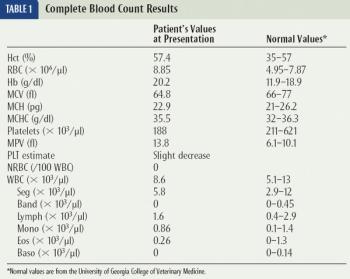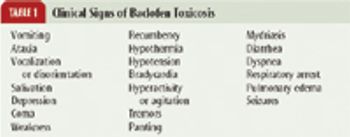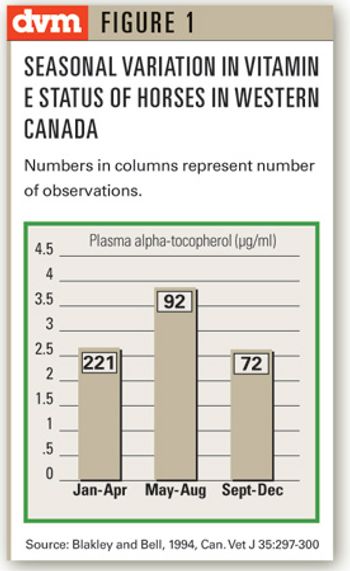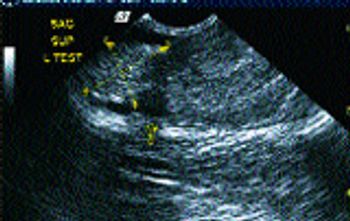
Duramune Adult Tech Report

Tallahassee, Fla.-A recent appellate court ruling rejects a 1978 precedent-setting decision that allowed non-economic damages for the loss of pets.

A 5-year-old, 114-lb (51.8-kg) neutered male German shepherd was examined because of a three- to four-week history of bloody preputial discharge and prostatomegaly.

Although esophageal disorders are less common than gastrointestinal diseases, they are not as rare as some practitioners think.

Baclofen is a centrally acting skeletal muscle relaxant.

Des Moines-John T. Waddell, DVM, MBA, was installed as the 35th president of the American Association of Swine Veterinarians (AASV) vowing to use the association expertise to solve important industry issues.

Gainesville, Fla.-Building on years of basic science that helped pinpoint a region of the rat brain that affects spatial awareness, University of Florida (UF) researchers are now testing the ability of antibodies to restore brain function after a simulated stroke.

Columbia, Mo.-In the movie, "The Lord of the Rings," Gollum was a computer-generated creature whose movements were created by filming an actor with reflective markers attached to his body.

The man wanted to know if I would be interested in using his company for night security.

Washington- In an age when activist often means more than mere protester, FBI experts warn veterinarians and those in the animal industry that extremists are elusive, dangerous and hard to predict.

Columbia, Mo.-In the movie, "The Lord of the Rings," Gollum was a computer-generated creature whose movements were created by filming an actor with reflective markers attached to his body.

Vitamin E is an essential nutrient for horses beneficial in combating the multitude of effects of free radical production that can damage membranes and components of cells.

Signalment: Canine, Labrador Retriever, 12 years old, male, 73 pounds.

Philadelphia-Equine Cushing's disease was identified as the most common cause of laminitis among horses in a primary care veterinary practice.

Q. How does one manage dogs with diagnosed osteosarcoma?

Cleveland-A line has been drawn. Veterinarians in favor of increasing welfare standards, raising pet worth and dismantling sow gestation stalls hold steadfast on one side.

Jorgensen Laboratories, Inc. introduces the Buster Nylon plastic basket muzzles.

Vedco introduces a unique handheld mobile tonometry unit for measuring intraocular pressure in animals that can be a tip-off for the onset of glaucoma.

Jorgensen Laboratories, Inc. introduces the Marq-Easy Thermoplastic splinting material.

Datum Filing Systems added the Stak-N-Lok2 to its product line.

Jefferson City, Mo.-Legislative proposals in Missouri are calling to rescind state law forcing physical therapists working on animals to practice under a veterinarian's supervision.

Vedco introduces a lightweight, portable, device that uses pulsed electromagnetic field therapy said to enhance pain management, speed healing and promote wellness.

Wysong Corp.'s Biotic Supplements are designed to restore natural living food elements to processed foods, now includes Call of the Wild.

Last week, sensing that spring was in the air, I realized that it was time for my annual visit to our old friend and colleague, Dr. Leonard D. Hardway. As you may recall, Leonard is a stressed out veterinarian who now resides at The Cold Ember Home for Burned Out Veterinarians, located in Rope's End, Wisconsin.

Sooner or later, most professionals will find themselves in front of a camera or microphone.

ReproTec Inc introduces the ReproTest for Bulls - Chute Side Test for Fertility Associated Antigen (FAA).

Wysong Corp. introduces E-Biotic, a highly palatable sprinkle-on formulation designed to ensure the presence of nutrients commonly lacking in rations.

Anthro Corp. and Technology Furniture? introduce the Elevate, Electric Lift Table.

SolidTech received licenses to produce and sell three new vaccine products for the cattle industry.

Synbiotics Corp. announces USDA-approval of its Witness HW canine heartworm antigen test kit. The heartworm test rejoins Synbiotics Witness line of veterinary products that includes the Witness Relaxin pregnancy test for dogs and cats.